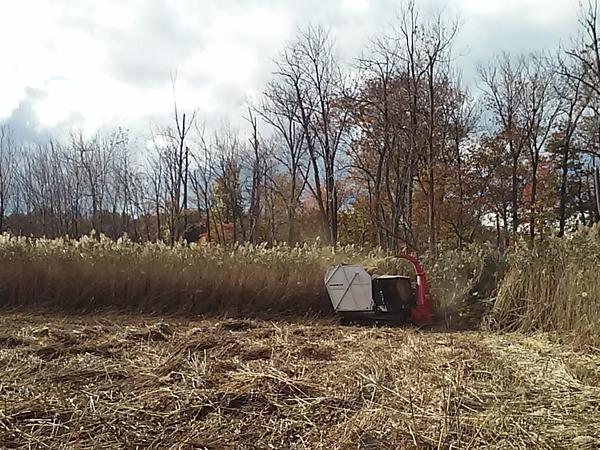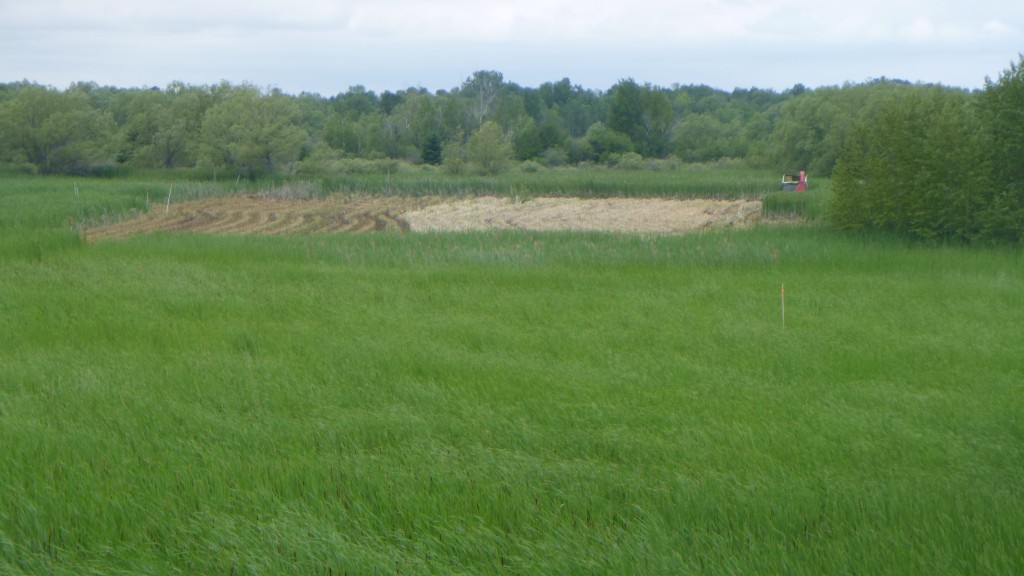November 19, 2015
Shane Lishawa, Loyola University Chicago; Dennis Albert, Oregon State University; Beth Lawrence, University of Connecticut; Linda Sekura, Cleveland Museum of Natural History contractor
Our collaborative team of researchers and restoration practitioners are working throughout the Great Lakes to pioneer a new approach to restore wetlands impacted by invasive Typha spp. (cattails), Phragmites australis (common reed), and Phalaris arundinacea (reed canarygrass): harvesting invasive plants and utilizing their abundant biomass. We aim to restore thousands of acres of Great Lakes wetlands impacted by invasive plants, and re-purpose biomass for low-carbon green energy (biofuel pellets and biogas), compost, and soil amendments.
Background
Since 2010, we have evaluated how mechanically harvesting invasive plants affects biodiversity and ecological functions. Our results have demonstrated that removing the abundant aboveground biomass reduces Typha dominance and increases native plant diversity by stimulating seed bank germination (Lishawa et al. 2015). Similarly, the Cleveland Museum of Natural History (CMNH) has documented a robust native seed bank response following small-scale Phragmites harvests in a Lake Erie coastal marsh (Unpublished 2009). Experimental work has also demonstrated that native species are more persistent following Typha biomass harvesting than after herbicide application (Lawrence et al. In Review).
Harvesting also removes significant quantities of nitrogen and phosphorus from wetland ecosystems, thereby targeting nutrient pollution, one of the primary causes of invasive plant dominance in many Great Lakes coastal wetlands. While herbicide treatments are more effective at killing invasive plants, we have found that herbicides can actually increase pore water nutrient content following application (Lawrence et al. In Review), setting the stage for reinvasion by nutrient-hungry invasive plants.
Restoration
In 2015, our first year of large-scale harvesting, we worked in seven Great Lakes wetlands, from Lake Superior to Lake Erie. Below, we highlight these projects by region:
Northern Michigan
Coastal wetlands in this region are some of the highest quality in the US Great Lakes with relatively isolated populations of invasive plants spread over a large area. In a USEPA-GLRI funded project we are controlling invasive Typha populations through biomass harvesting. During summer 2015, we harvested Typha from over 50 acres of four Great Lakes coastal wetlands on northern Lake Huron, the St Marys River, and Lake Superior using a low-ground pressure wetland plant harvester. We are conducting detailed monitoring of plant, nutrient, and greenhouse gas responses to harvest treatments. A portion of the harvested biomass is being composted by a dairy farmer and used to amend sandy soils by recycling nutrients and organic matter, and a portion is being converted to biofuel pellets to be used in multi-fuel pellet stoves. Additionally, we harvested Phalaris from a wetland in Sault Ste. Marie that is being converted to biofuel pellets. This project is led by the Loyola University Chicago: Invasives-to-Energy program and includes partners from Oregon State University, DePaul University, the University of Michigan Biological Station, and Gregory Zimmerman from Lake Superior State University.
Mentor Marsh State Nature Preserve, Northeast Ohio
The Power-from-Restoration collaborative, led by CMNH, has a primary goal of globally accelerating restoration in ecosystems to expand local green infrastructure by developing markets for invasive plant biomass as an initial feedstock. A pilot Phragmites harvest-to-digester project was initiated in 2012 and Bio-gas was produced lab-scale at facilities in Ohio in 2013 and in Belgium in 2014. In 2015, Loyola lent field equipment for the collaborative’s ongoing larger-scale project, piloting their harvester to remove 2+ acres of Phragmites from the heavily invaded Mentor Marsh, a 700-acre Lake Erie coastal wetland. CMNH treated the Phragmites with herbicide approximately 3 weeks prior to harvesting to help ensure that the Phragmites will not sprout back next year. Harvesting will allow light to penetrate to the soil surface and should stimulate a seed bank response. Approximately 10 tons of harvested biomass was delivered to Quasar Energy Group’s Zanesville, Ohio anaerobic digestion facility. The biomass is being used to produce sustainable bio-gas that offsets fossil fuels and is used in the same way as natural gas; Quasar uses the bio-gas to fuel their trucks, power their facilities, and sell the power and fuel. The Power-from-Restoration.com website is capturing the steps and lessons learned to share, along with other cost-saving methods. Importantly, preliminary effluent experiments at Case Western Reserve University showed that following digestion, Phragmites seeds and rhizomes were no longer viable. This pilot project was made possible thanks to contributions by many Power-from-Restoration team members, funding from the Ohio Lake Erie Commission, and the use of Loyola University’s wetland harvester.

This harvester causes minimal ground disturbance by distributing pressure across the tracks. Photo courtesy of Linda Sekura.
Oshkosh, Wisconsin
We partnered with the University of Wisconsin-Oshkosh to harvest invasive Typha from a heavily invaded University owned marsh on Lake Butte des Morts in Central Wisconsin. The biomass harvested from this wetland will be utilized in the UW Oshkosh Urban Anaerobic Dry Biogas System this winter. Renewable energy produced in this digester provides electricity and heat to UW Oshkosh.
Lawrence BA, Lishawa SC, Rodriguez Y, Tuchman NC. (In review). Herbicide management of invasive cattail (Typha × glauca) increases porewater nutrient concentrations.
Lishawa SC, Lawrence BA, Albert DA, Tuchman NC. 2015. Biomass harvest of invasive Typha promotes plant diversity in a Great Lakes coastal wetland. Restoration Ecology. 23 (3): 228-237.

